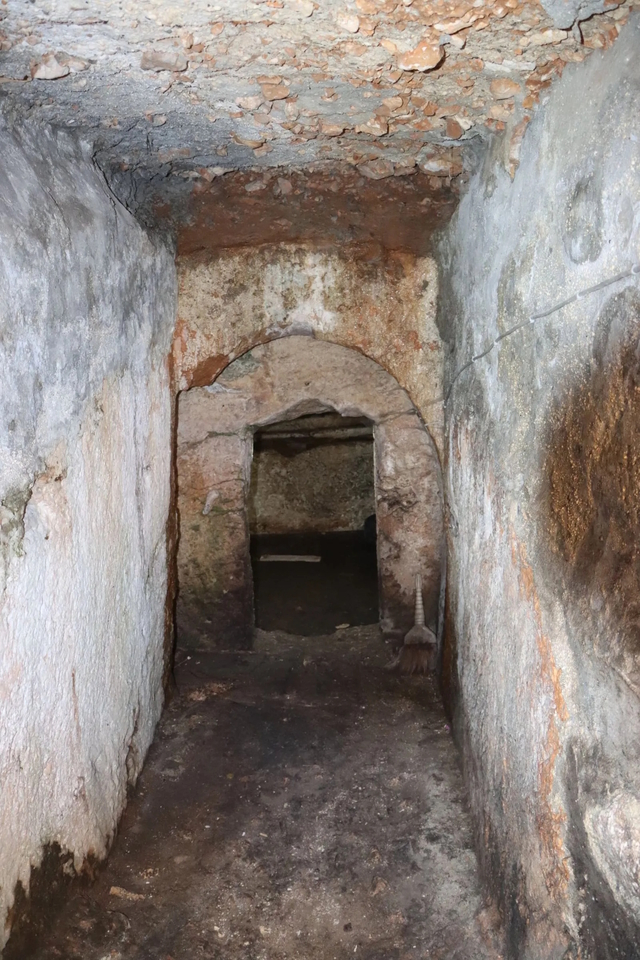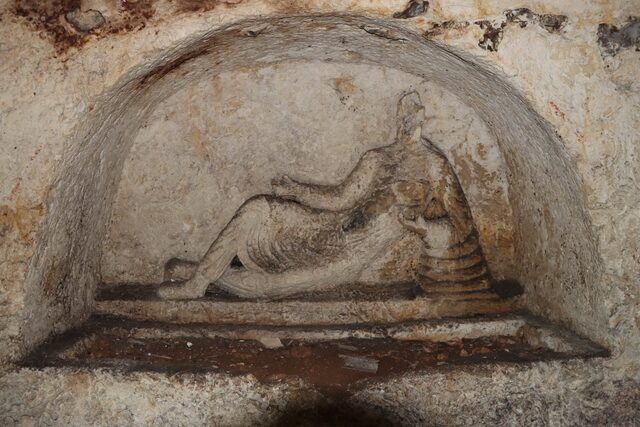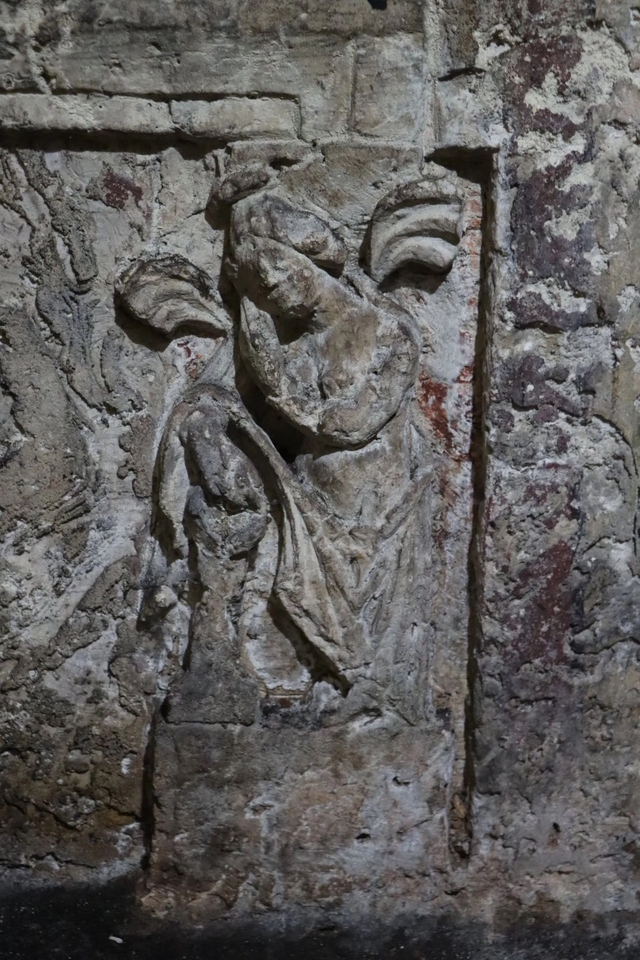In a remarkable turn of events, a hidden treasure from the past was uncovered right beneath the floor of a private home in Şanlıurfa, southeastern Turkey. A 2,300-year-old rock-cut tomb was discovered in the courtyard of a house, hidden away behind a plaster crown decoration on the building’s proscenium arch. This unexpected discovery has shed new light on the area’s deep and varied history, revealing insights into the ancient lives of the people who inhabited this region long before the modern era. This tomb, adorned with intricate reliefs and an ancient inscription, has the potential to unlock secrets about the religious beliefs, traditions, and artistic expressions of a civilization that flourished centuries ago.
The Tomb’s Structure: A Closer Look at the Rock-Cut Design
The tomb is remarkable not just for its age, but also for its unusual rock-cut structure. Located in the courtyard, the tomb consists of a single chamber that has withstood the test of time. It was carved into the bedrock, and its preservation speaks to the engineering prowess of its creators. The reliefs adorning the walls of the tomb showcase intricate and unusual iconographic motifs, providing a glimpse into the ancient culture that built it. The shape of the tomb, with its hidden location, suggests a deliberate effort to conceal it from plain sight—perhaps as a way to honor the dead or to safeguard the sacred burial from future desecration.


Video
Watch the video about the unique rock tomb discovered in Southeastern Türkiye’s Şanlıurfa – a fascinating archaeological find!
The Reliefs: Decoding Iconographic Motifs
Inside the tomb, the most striking feature is the series of reliefs that decorate the walls. At the center, a man is depicted reclining in what is known as the “banquet pose,” with his left arm extended. This depiction is a key motif, suggesting that the figure may have been an important person, perhaps a leader or a religious figure. The “banquet pose” is often associated with royalty or high-status individuals in ancient cultures, hinting at the social hierarchy of the time.
In the corners of the tomb, two winged figures are carved. These figures appear to have female features, and their presence raises intriguing questions about the spiritual or mythological beliefs of the people who constructed the tomb. Winged figures often symbolize divine beings or celestial beings in ancient iconography, hinting at the possibility that this tomb was not just a burial place but also a site for religious or ceremonial rituals.
Other motifs found in the tomb include human figures, animals, and plants. These reliefs serve not only as art but as important historical documents, giving us insight into the daily life, religious practices, and artistic expressions of the period. These figures may have been designed to reflect the environment, beliefs, and values that guided the people of that time.

The Inscription: A Faded Clue to the Tomb’s Age and Origin
One of the most intriguing aspects of the discovery is the inscription that was found inside the tomb. Painted in ochre on the interior side of the entrance door, the inscription is faded and damaged, making it difficult to read. However, efforts are already underway to decipher its contents. The inscription may offer clues about the date of the tomb and could potentially help archaeologists better understand the cultural context in which it was created.
The importance of this inscription cannot be overstated. Inscriptions often serve as time markers, linking the artifacts to specific historical periods, events, or individuals. This particular inscription might hold the key to unlocking the tomb’s precise origins, providing more detailed information about its creators and the people buried inside.
Şanlıurfa’s Historical Significance: A Region Steeped in Millennia of Culture
Şanlıurfa is a city that has been central to human history for millennia. Just seven miles from Göbekli Tepe, the world’s oldest known temple, Şanlıurfa is often regarded as a cradle of civilization. This city has witnessed the rise and fall of numerous cultures, from the Hittites and the Romans to the Ottomans. The discovery of this rock-cut tomb only adds another layer to the already rich historical record of the region.
The presence of Göbekli Tepe, with its extraordinary prehistoric temple complex, places Şanlıurfa at the heart of the agricultural revolution, which changed the course of human history. But Şanlıurfa’s significance doesn’t stop there; the city also houses other remarkable historical sites, such as the ancient Harran, the Balıklıgöl complex, and the Şanlıurfa Castle. Each of these sites tells a different story of human ingenuity, belief, and creativity, contributing to the city’s identity as a living museum of human history.

The Cultural Inventory Project: Efforts to Protect and Preserve Şanlıurfa’s Heritage
The discovery of the tomb was made possible through the efforts of the Cultural Inventory Project, an ongoing initiative that aims to re-document and preserve the region’s archaeological assets. This comprehensive project is dedicated to identifying new sites and monitoring the condition of existing ones, with the goal of protecting Şanlıurfa’s rich cultural heritage for future generations.
With approximately 6,000 historical assets in the province, including rock tombs from the Hittite and Roman periods, the need for such a project is evident. Many of these sites are at risk due to environmental factors, urbanization, and neglect. The Cultural Inventory Project plays a vital role in ensuring that the historical treasures of Şanlıurfa are not lost to time and that they continue to tell their stories to those who visit.
Conclusion: Unveiling the Past and Its Future Impact
The discovery of this 2,300-year-old rock-cut tomb in Şanlıurfa is a testament to the timeless nature of the city’s historical significance. The intricate reliefs, mysterious motifs, and faded inscription within the tomb are pieces of a puzzle that archaeologists and historians are eager to solve. As researchers work to decipher the inscription and further investigate the tomb’s contents, we can only imagine the new revelations this discovery might bring.
For the people of Şanlıurfa and the world, this discovery represents more than just an ancient burial site—it is a direct connection to the past, offering a glimpse into the lives and beliefs of those who lived long before us. As the city continues to uncover its hidden treasures, we are reminded of the importance of preserving and protecting our shared cultural heritage.
Video
Watch the video as someone shares their unbelievable discovery – you won’t believe your eyes!



